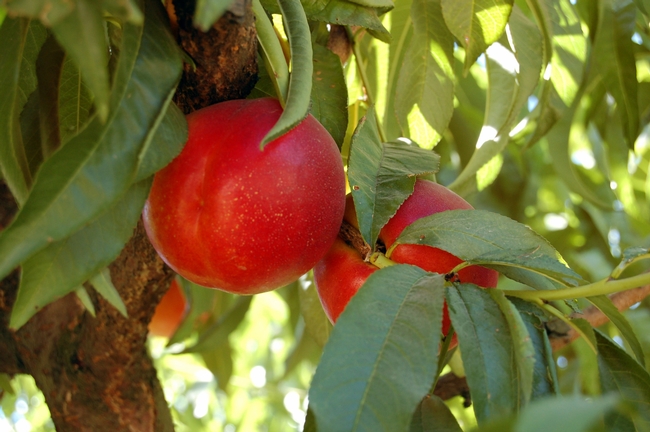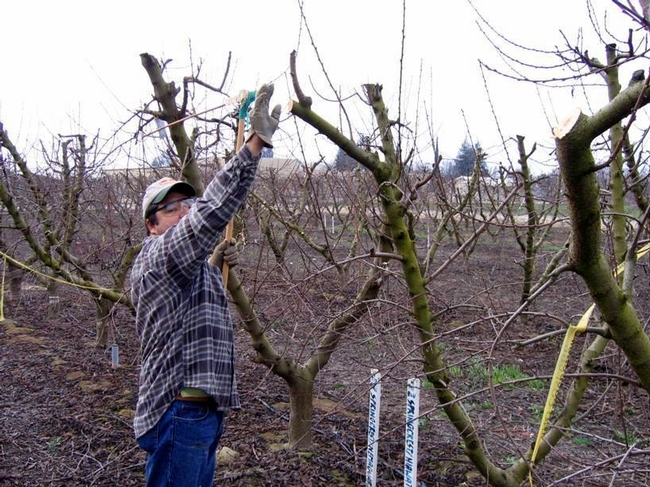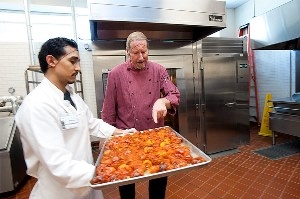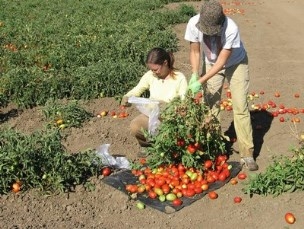UC Food and Agriculture Blogs
Scale Insects: Recognizing and Managing
People sometimes don't recognize scales as insects, but understanding scale types and signs of their presence will enable you to best manage them if encountered on your plants. Scale insects are circular, elongate, or oval insects that often resemble...
UC explores ladderless peach and nectarine orchards
Can shorter peach and nectarine trees reduce labor costs?
The answer may be developing soon at a 4-acre test orchard south of Fresno, where University of California researchers are planting semi-dwarfing rootstocks as part of a large, integrated experiment on virtually every aspect of peach and nectarine production.
“We're designing ‘ladderless' orchards, which have the potential to cut labor costs by 50 percent or more and improve worker safety,” said UC Cooperative Extension specialist Ted DeJong, a plant physiology professor at UC Davis. DeJong and Kevin Day, a Cooperative Extension farm advisor in Tulare County, are leading the extraordinary experiment.
Conventional peach and nectarine trees grow about 13 feet tall. Setting up, climbing and moving ladders to prune the trees and harvest fruit consumes about half the workday. Ladders are dangerous, too, which is why peach and nectarine growers pay about 40 percent more for workers' compensation insurance than growers who work with more low-lying commodities, like grapes.
Developed by breeders at UC Davis, the new rootstocks will produce trees that grow about 7 or 8 feet tall and can be pruned and harvested from the ground. With the right orchard management — which Day and DeJong will test at their plots at the UC Kearney Agricultural Research and Extension Center, near Fresno — the shorter trees could produce just as much high-quality fruit as their lofty kin.
“Ladderless orchards would be huge for our industry,” said Bill Chandler, who grows several varieties of peaches and nectarines on his 250-acre Chandler Farms in Selma, California. “There are so many costs associated with ladders that many growers are switching over to almonds just to stay in business. It costs me $1,400 an acre to thin our trees.”
“Even with conventional rootstocks, I prune my trees so workers can take two fewer steps on the ladder come harvest time,” he said. “And the savings are huge, even with that. It's important to keep farm work safe. And it's important to keep farming viable, or else we'll be getting all our produce from overseas.”
Shorter trees are just one of the elements of DeJong's and Day's experiment, which explores best practices for keeping peach and nectarine production economically and environmentally sustainable. Funded by the UC division of Agriculture and Natural Resources, their model orchard will integrate virtually every UC pomology advancement in the past 30 years.
You can read more at: http://www.caes.ucdavis.edu/news/articles/2014/08/ladderless-peach-and-nectarine-orchards-explored
The Good Side of Pruning
In the December 2013 issue of the Green Bulletin, we looked at “Pruning and Tree Physiology: The Bad and the Ugly” for pruning and maintaining ornamental trees as well as some pruning pitfalls. However, pruning can also be highly beneficial...
UC Davis tomatoes provide year-round healthful eating for college students
At the same time, chefs and food buyers at universities, particularly the University of California, are selecting for high-quality fruits and vegetables, produced locally and sustainably. Universities with strong food sustainability programs are rightfully proud of what they're doing to educate students about food production, health, and nutrition. UC Davis Dining Services prioritizes the purchase of locally grown food (ideally within a 50-mile radius of campus). Most University of California campuses have similar programs.
At UC Davis, fresh roma tomatoes are picked each August from the 300-acre Russell Ranch, part of the campus's Agricultural Sustainability Institute, then processed within hours by campus Dining Services to provide year-round tomato sauce for pizza, pasta, and ratatouille. All told, 10,000 pounds of tomatoes are processed during a two-week period in August. About 29 percent of the total food served in the campus's residential dining halls is from local, organic or sustainable sources.
The tomatoes grown at Russell Ranch are part of a long-term academic research project that examines factors such as farming methods, irrigation needs, crop rotations, yield, and nutritional content. At the end of the growing season, some of the many tons of tomatoes are purchased by Dining Services at market value.
Emma Torbert, an academic coordinator at the UC Davis Agricultural Sustainability Institute, noted, “Connecting the food system to the research is really interesting. A lot of times there is confusion about where our food is coming from. The more people are educated, the more educated decisions they can make.”
Many UC Davis faculty and staff are so impressed with the food choices at the dorms that they purchase individual meal tickets and enjoy lunches made with the campus-grown tomatoes, herbs, and other vegetables, all of which are part of the daily food array. Public dinners are also offered periodically at the dorms so that community members can sit amongst students to taste and learn about the sustainability programs in the dorms.
Additional Information:
- Video: Farm to Table, UC Davis Tomatoes; 2010
- Slide show of this year's UC Davis tomato harvesting and processing system; 2014
- Sustainable Foodservice Progress Report 2014, UC Davis Dining Services
- Two videos of UC Davis students who work at the Student Farm to produce food, including one on tomato sauce production
- “Tomatoes: Safe methods to store, preserve, and enjoy.” UC Agriculture and Natural Resources, free publication
Managing Weeds Under Drought Conditions
[From the August 2014 issue of the Green Bulletin, a newsletter for landscape and structural professionals] While one of the best methods to reduce weeds is to not water them, there are some that survive even in drought conditions (Fig. 1). As we...






